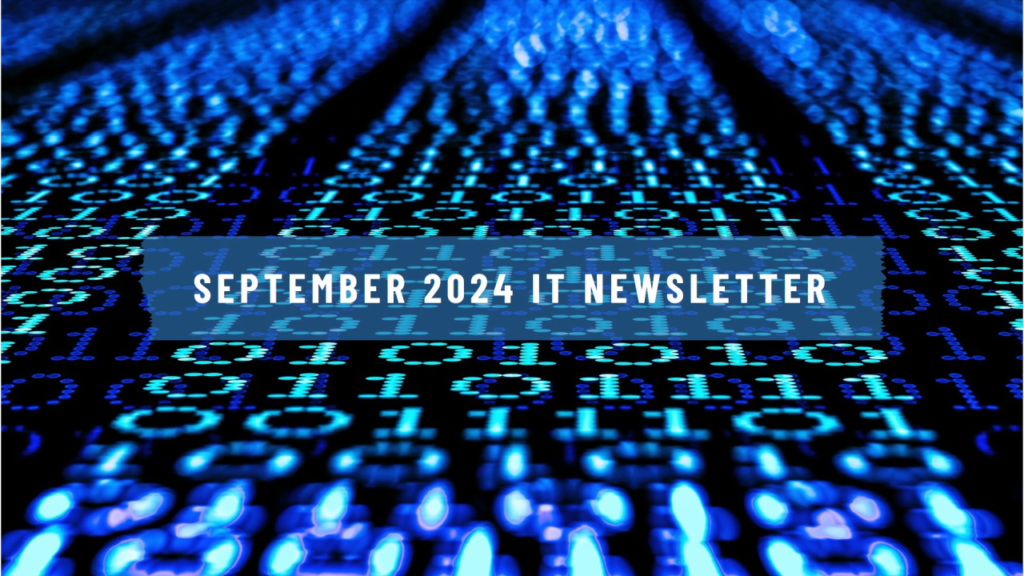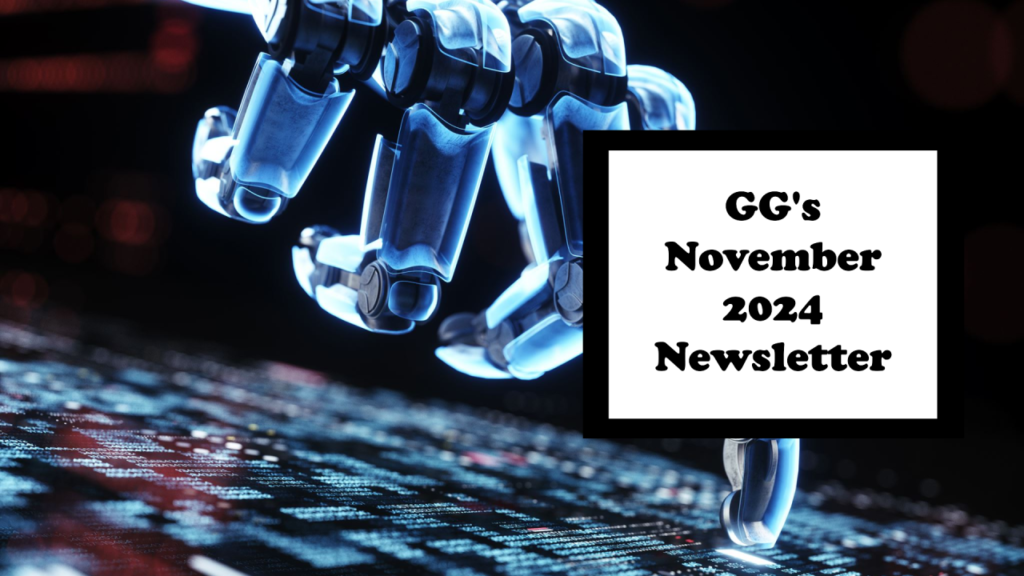In this October digest, I speak greatly about the European crisis and the opportunities linked to that.
- I elaborate on the chipset market and how that has been also influenced by the cars crisis
- Focalize on discussion on the main industries where real AI game changing is to come
- Speak about the risks of wrongly training AI platforms causing AI madness
- Discussion around return to work theme and how that could influence GenZ
- Environment related discussion specifically focused on the AI power increase in datacenters
- Discuss around a future trend on Human Digital Twins that aims to integrate a view of wellbeing and work related information for people combining personal and working info.
Let’s dig in the details.
Please appreciate this newsletter is own manually written with the purpose to keep content creation authentic and creative as much as possible.
Disclaimer
This newsletter is a combination of my own analysis and insights, informed by publicly available information and industry trends.
All my comments represent my personal opinions about IT trends in enterprises, based on the news we can all read and my correlations for further conversation and exchange always constructive and respectful.
It’s intended to come on a monthly to quarterly cadence based on the relevant topics I believe make sense to share and will keep a structure as much as possible technology and vendor agnostic.
Technology in Cars
September just ended, we saw many signals in the European market regarding crisis and over the world all the challenging situations causing markets high fluctuations.
The German automotive VW, first time after 75 years, comes to the idea to close two productions sites in Germany. At the same time Intel, again in Germany, planned to stop (formally hold for 2 years) the investment to build a new factory of chipsets (for 30B$) due to its actual crisis situation, putting in trouble the plan for Europe to reduce by 2030 its dependency on outside EU borders production of chips.
There are clear indications that the electrical cars market competition from China for European automotive and the acceleration of AI and SoC chips from competitors of Intel, have been driving such type of situation. At the same time as consequence of the over productions of semiconductors after COVID demand and for electrical cars as this demand slowed down and AI chipset demands rose, several chipset producers started to focus on the AI shift, in some cases quite reorganizing like STMicroelectronics, in some other like Nvidia just accelerating an already existing focus. The last few years we saw shift to own production of chips for many US tech enterprises especially with the proliferation of SoC. However I like to focus on some correlations of technological events here to look more on the forward trends rather than focusing on root cause of the past.
EU Crisis
During September, Mario Draghi, as consultant to Ursula Von Der Leyen, delivered his one year analysis report about European future competitiveness indicating also key weakness and areas to invest. He spoke about a 750B-800B$ per year spending expected between 2025 to 2030 to remediate to a situation that, if not properly touched, will lead to the progressive agony of European community by 2050 latest. This approach included a difficult to digest and implement unique market strategy and found resistance on the overall cost of the approach. However, in his report is useful to identify some key highlights to takeaway.
There have been defined three key aspects to focus going forward for Europe evolution: innovation, decarbonization and security.
It’s interesting to see, in the detailed report, that the innovation is seen not only important by itself but also influencing the decarbonization. At the same time, security is highly linked to also increasing the production within the EU borders to reduce dependency from other countries that was indeed in the focus of EU for example for the chipset production in Europe by 2030 that will be most probably not achieved.
Statistics say that EU reached the peak of population and predictions are that by 2050 will come a decrease from 742M to 703M or 5% in population. Here you can refer to the same Draghi’s report or to for example Population Pyramids.

Digging in the Draghi’s analysis is quite clear on the fact the clouds providers competition is lost for Europe. I also share this perspective considering the multiple years of investment that brought those hyper-scalers to reach the actual maturity. In his report can be found that cloud providers headed in Europe are representing just 2% of the cloud market where over 65% is mainly in US from the three major hyper-scalers (Microsoft, Amazon, Google). Where he sees synergies is around the AI development on specific areas that, being in an early stage of maturity cross the world, could give the chance to Europe to step up its presence even if depending on computer power from the big hyper-scalers all US owned.
In the report there is the suggestion to use power of HPC from Europe (mostly from big research centers) to use it for AI calculation but I doubt this solution will bring the same value once will start to compose with other services, including data integrations, typically part of the integrated and modular solutions coming from the big US hyper-scalers. I feel that dependency on the US hyperscalers will not go away due to the variety and elasticity of components available in such environments.
AI
An interesting aspect is about Digital Transformation in AI time:
- In this report Draghi also projected 60-110B$ in revenue increase in the market of Pharma from the optimization coming from the drugs analysis augmentation thanks to AI as one of the key aspects. Also McKinsey reported the same trend in January, giving a clear idea that in the AI we have a good real opportunity to improve for such type of businesses more mature in advanced data elaboration.
- Clearly in the AI development, it will be key to focus on the P&L impact of the AI and its cost as nicely also spot by RussellReynolds. Some areas like robotic process automation with AI, are giving some improvement from automation and reduction of redundant activities and are achievable from many enterprises but have limited value increase. Difference starts with work augmenting, typical from creating process improvement including human digital twin where the augmenting will start to ramp up the value creation for the enterprise but will require a bigger effort to be rolled out in all those business still on an early stage of maturity. In this area we see interesting movements coming also from some IT historical ITSM vendors extending their capabilities toward a platform approach to build integration toward business key data and analytics and use the same platform also for automation cross solutions. Finally the highest level of transformation with AI with full processes redesign, will require an already good maturity of the enterprises also in the areas of Data science to develop further level of value creation from the introduction of AI at highly integrated processes level.
- As we raise the level of complexity of AI usage and tight integration with data, we see opportunities get stronger in term of impact but also reduce the number of enterprises capable to get value of it and the effort to achieve, based on the actual business cases available on the market. One challenge I foresee, especially with lower maturity businesses, will be to invest a proportion of IT budget in AI and its prerequisites, without eating part of the operational IT budget and granting those investments long enough to start to gain a consistent value creation increase. More mature enterprises are already structured to split those costs in the corresponding P&L at the right level of granularity to help to accelerate the most urgent priorities from business but the risk to have a benefit of AI in a specific department only or running from IT only without the proper business commitment, it’s a risk to consider because the most advanced digital transformations (including AI) are requiring long term focus and overall enterprise involvement.
Separated topic is about what is also named AI Madness:
- One aspect of the limited or late regulations that we ran so far for the AI is that for example for some time, big part of training of AI has been done using contents from Internet not always freely accessible. Many content creators started to make noise about AI could not just be trained with intellectually proprietary contents. As consequence, many contents have been built automatically with AI especially in area of translation. As side effect the need of huge data source to train AI, tech AI companies went to use the same data that were already AI generated as source, causing a typical case of Model Autophagy disorder or MAD. In other words, systems risk to get less and less in quality of answers because they train themselves using contents from Internet that were AI generated as well. A quest for high valuable data sources and intellectually protected contents will be definitely ramping up to not risk to collapse the whole engine.
Quantum Computing
There are many other interesting insights in the European future competitiveness but one element I found relevant as risk for Europe is about the quantum computing lack. Out of 10 top tech in quantum computing, 5 are in US, 4 in China, none in Europe. This is an area that I believe will ramp up strategically in the upcoming 5-10 years especially linked to AI due to the capacity to use quantum computing capabilities to approach for example deep learning at next level scale.
If interested, I have a separated free technical channel about this topic calledMacQuantum. I plan to publish contents later in the future as I will study further around it. I think that, If we are on the prehistory stage of AI, we are on the start of life in the universe when we speak about quantum computing and AI.
So correlating aspects, we see that some areas of the world spent over the last 20 years on transforming more in digital businesses. There are no European businesses that grow from 0 to at least 100B$ in the last 50 years but in US, 6 enterprises grow in the same time from 0 to 1T$. All these US business are digital businesses.
Those businesses built the infrastructure to scale AI while other areas of the world remained on the more historical manufacturing model business but started to spend much to regulate those new digital businesses models ramping up (for example with the EU AI Act).
Environment, Social, Governance (ESG)
In the Social we saw the following in September:
- It has been also the month of the sanction to Apple from European Community for 13B€ due to EU tax case from the past.
- The remote work strategies made even less transparent the overall workforce allocation as this accelerated dramatically during COVID.
- Governments are adjusting rules, some enterprises are changing the initial plan partially, some like Amazon for example announced they will be all back in the office 5 days a week for everyone from the 2nd of January 2025 (at least in US while in Europe some different rules will apply).
- These changes of work conditions and regulations evolving also on the right to disconnect for remote workers in EU, bring, from my perspective, a clear evolution on the attention for the wellbeing and employees relevant personal data to care that will drive the ramp-up of the evolution of human digital twin and the related HRIS and fitness capabilities, still keeping a clear consideration of the aspects exposed by the AI Act regulations (here I summarized key points) in term of privacy and emotions interpretation limitations applying on AI engines.
In the area of Environment we saw:
- It’s interesting to see on one side the need of more power, more AI chipset, computation and data storage capabilities, on the other side we know this is going to raise the level of energy needs.
- It’s interesting that just in August I was referring in a post to few risks I would see about discrepancy in consuming power needs for clouds datacenters and regulations restrictions in producing some type of energies in some countries. Europe is again a case where there is not a common view about nuclear for example.
- My reflection is questioning what will happen with the cost of clouds services in those countries that will require to have data hosted locally and will have restrictions around type of energy sources to operate? In my post I was referring for example to Germany, that historically had the need to have within their borders clouds datacenters to guarantee strict data compliance but at the same time decided to go against nuclear and has set an high bar around emissions.
- We just saw in September that Microsoft is getting restarted an old reactor in US inPennsylvania due to its AI power needs. Just for info this is the plant that was the location of the most serious nuclear meltdown and radiation leak in US history.
Market Evolution
On the chipset market there are many transitions ongoing. Qualcomm and ARM still in September tried to scale up Intel to acquire their business, TSMC continues to grow its US production, at the same time is happening some restructuring, for example in Intel and STMicro. The 2025 sees a big grow in the personal computers driven by the AI powered new chipset, listening also to the opinion of big experts like Michael Dell. Definitely an increase of replacement of computers with AI powered would bring more revenues for those vendors linked to that type of portfolio (Intel, AMD, Qualcomm) but will have to be effectively proofing the value of AI powered computers to push such accelerated loop of renewal. Difficult to speculate, and is not my focus, on the market consolidation for chipset but definitely something could happen in the upcoming months.
Digital Transformation in HR Platforms
One aspect where I see interesting possible future positioning for Europe, considering the high regulations around privacy, is about building proper services around highly privacy contents, for example models for human digital twin with AI and maybe use the HPC power from Europe to guarantee those data elaboration would remain within a certain highly regulated boundary. In this area where many phycological and body sensible related information will be progressively stored and augmented to build a virtual view of people, it will come the need to have a proper control on these information and the opportunity to interface with healthcare, insurances, pharma and food enterprises, at least, to introduce capabilities bringing real unique value. Here we speak about crossing data of health, food, body trends, wellbeing, remote and onsite work stress and productivity together with gamification, prediction and reduction of illness, general life quality improvement and will bring improvement for all the parts involved. It’s definitely an opportunity that has to be explored from my point of view, on which EU already worked in definition and that has a big level of attention ramping up and I see opportunities to be integrated in the middle future with the full employees integrated wellbeing and HRIS strategies on one hand and the personal modern digital fitness augmented capabilities, health monitoring and avatar on the other.
GG



